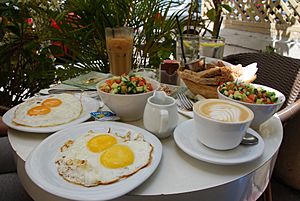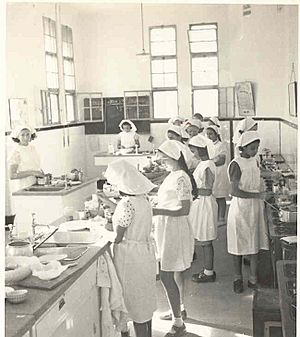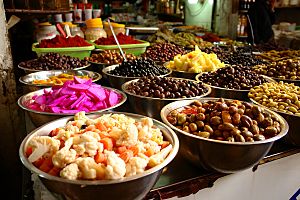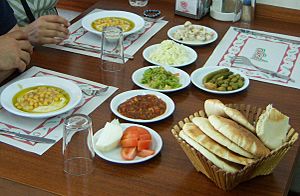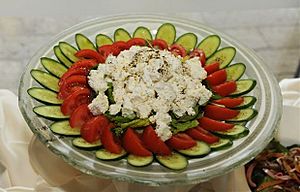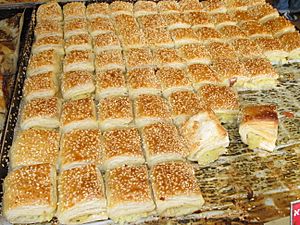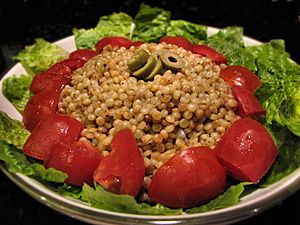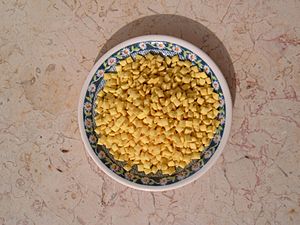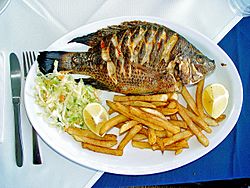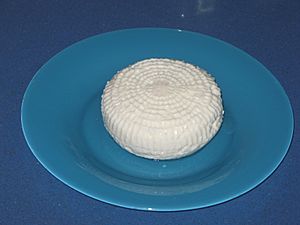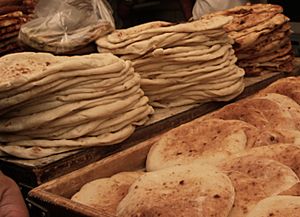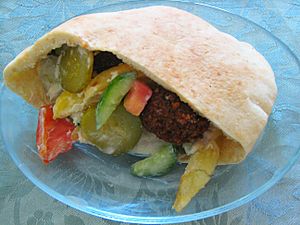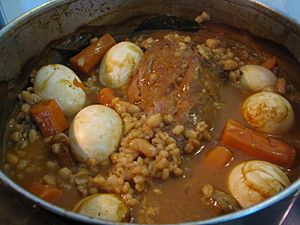Israeli cuisine facts for kids
Israeli cuisine is the food of Israel. It includes both traditional dishes from the area and foods brought to Israel by Jewish people from all over the world. Since Israel became a country in 1948, a special mix of Jewish cooking styles has grown.
Israeli food uses ideas from different types of Arab cuisine and Jewish cooking styles, especially from Mizrahi Jews (from the Middle East and North Africa), Sephardic Jews (from Spain and Portugal), and Ashkenazi Jews (from Eastern Europe). Many foods popular in Israel today, like za'atar (a spice mix), falafel (fried chickpea balls), hummus (chickpea dip), shakshouka (eggs in tomato sauce), and couscous, are also common in other Middle Eastern and Mediterranean cuisines.
The food is also shaped by what grows well in the Mediterranean region, such as fruits, vegetables, dairy products, and fish. Jewish traditions, like keeping kosher (special food rules) and customs for Shabbat (the day of rest) and other Jewish holidays, also play a big role. Foods like challah (braided bread), jachnun (Yemenite pastry), malawach (flatbread), gefilte fish (fish patties), and sufganiyot (donuts) are examples of these special foods.
Over the years, new dishes have appeared, using local farm products like oranges, avocados, and dairy. Chefs who trained in other countries have also added international flavors to Israeli cooking.
Contents
History of Israeli Food
Ancient Roots
The food traditions in Israel go back 3000 years! Over time, food from Asia, Africa, and Europe, along with religious and ethnic customs, all mixed together. We know about the food from ancient times, around 1000 BCE, thanks to old records and discoveries.
During the time of the Second Temple (516 BCE–70 CE), Greek and Roman cultures influenced the food, especially for important people in Jerusalem. Meals were fancy, with tasty starters, drinks, fish, meat, pickled and fresh vegetables, olives, and sweet or sour fruits.
The ancient Israelites ate foods that are still important in Israel today. These were called the Seven Species: olives, figs, dates, pomegranates, wheat, barley, and grapes. They also used imported spices because the country was a crossroads for trade.
After the Second Temple was destroyed and many Jews left Israel, Jewish cooking continued to grow in different countries. It was shaped by the local food, farming, and cooking styles of those places.
Early Jewish Communities
The Old Yishuv was the Jewish community living in the area before many Jews started moving back in 1881. Their cooking style was mostly Sephardi, which came from Jews in Spain before they were forced to leave in 1492. These foods then spread to places like the Balkans and the Ottoman Empire.
In Jerusalem, Sephardi and Ashkenazi Jews mixed their cooking styles with Ottoman cuisine. This created unique dishes like sambousak (pies), pastels, burekas (savory pastries), and stuffed vegetables, which are now Jerusalem classics.
Some Hasidic Jews from Eastern Europe also came in the late 1700s. They brought their Ashkenazi foods, but also made local versions, like kugel yerushalmi, a peppery, sweet noodle pudding.
New Immigrants and Food Changes
Starting in 1881, more Jews began moving to the area from places like Yemen and Eastern Europe. These early settlers wanted to use local foods and the Mediterranean climate. They started using vegetables like zucchini, peppers, eggplant, and chickpeas, instead of their old Ashkenazi cooking styles.
The first Hebrew cookbook, published in the 1930s, told cooks to use Mediterranean herbs, Middle Eastern spices, and local vegetables. The bread, olives, cheese, and fresh vegetables they used became the basis for the kibbutz (a type of community settlement) breakfast, which is still served in Israeli hotels and homes today.
Food in Early Israel
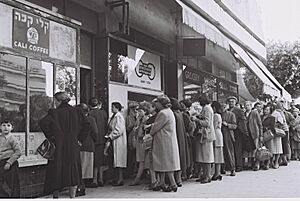
When Israel became a country, it faced many challenges. From 1948 to 1958, there was food rationing and a time of strict saving called tzena. Over a million new Jewish immigrants arrived, many from Arab countries and some who survived the Holocaust.
They came when only basic foods were available. So, people had to change their traditional dishes. For example, they used eggplant instead of liver for "chopped liver" and turkey instead of veal for schnitzel. These changes are still part of Israeli cooking today.
New foods like ptitim (a wheat-based pasta) were created as a substitute for rice. Vegetables like eggplant were used instead of meat. Inexpensive canned tomato paste, hummus, tahini, and mayonnaise added flavor and nutrition. Meat was hard to find until the late 1950s.
During the 1948 War of Independence, a local plant called khubeza (mallow) became an important food source. When Jerusalem was under siege and food couldn't get in, people picked khubeza leaves, which are full of iron and vitamins. Today, some chefs even serve khubeza in fancy restaurants. A dish from that time, ktzitzot khubeza (khubeza patties), is still eaten.
New Flavors from Immigrants
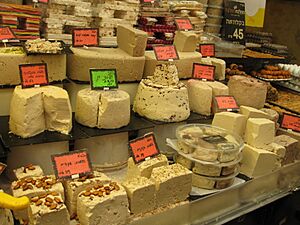
Immigrants brought their own food traditions to Israel. Before 1948, many waves of Jewish immigrants arrived, bringing different foods and cooking styles. People from Central Europe brought schnitzel and strudels. Russian Jews brought borscht (beet soup) and herring dishes.
Ashkenazi dishes include chicken soup, schnitzel, lox (smoked salmon), chopped liver, gefilte fish, knishes (baked dough with filling), and kugel (baked pudding). The first Israeli bakeries were opened by Ashkenazi Jews, who made popular cakes and pastries from Central and Eastern Europe, like babka (yeast cake) and chocolate rolls.
After 1948, many Jews came from Turkey, Iraq, Kurdistan, Yemen, and North Africa (especially Morocco). These groups, especially Mizrahi, Kurdish, and Yemenite Jews, often worked in army kitchens, schools, hospitals, and restaurants. This greatly influenced the country's cooking.
Mizrahi cuisine, from North Africa, features grilled meats, sweet and savory pastries, rice dishes, stuffed vegetables, and salads. It's very similar to Arab food. Other popular North African dishes in Israel include couscous, shakshouka, matbucha (cooked tomato and pepper salad), and chraime (spicy fish stew).
Sephardic dishes with Balkan and Turkish influences in Israel include burekas, yogurt, and taramosalata (fish roe dip). Yemenite Jewish foods include jachnun, malawach, skhug (spicy sauce), and kubane (baked bread). Iraqi dishes popular in Israel include amba (pickled mango sauce), different types of kubba (dumplings), stuffed vegetables, kebab, sambusac (fried pastry), sabich (eggplant sandwich), and pickled vegetables.
Modern Food Trends
As Israeli farming grew, new fruits and vegetables appeared. Cooks started trying new dishes with them. They also began using "biblical" ingredients like honey, figs, and pomegranates, and local foods like tzabar (prickly pears) and chickpeas. Since the late 1970s, people have become more interested in international cooking, using wine and herbs, and vegetarianism.
A more advanced food culture began in Israel when cookbooks, like Ruth Sirkis's From the Kitchen with Love (1974), introduced international cooking. Also, new restaurants serving Chinese, Italian, and French food encouraged people to eat out more.
The 1980s were important for food. More hope after the peace treaty with Egypt in 1979, better economy, and more travel abroad made people more interested in food and wine. Also, high-quality local ingredients became easier to find. For example, small dairies started making handmade cheeses from goat, sheep, and cow's milk, which became very popular. In 1983, the Golan Heights Winery started making world-class wines, changing tastes. People also paid more attention to making handmade breads and good olive oil. Better fish farming and agriculture meant lots of fresh fruit, vegetables, and herbs.
Cooking from different ethnic backgrounds, both Sephardic and Ashkenazi, has become popular again as Israel embraces its diverse society. Many ethnic foods are now found in markets, supermarkets, and restaurants. People are also trying foods from other backgrounds more often. This mixing of foods from different groups is creating a unique multi-ethnic food culture.
In the 1990s, international foods became even more popular. Sushi, for example, became a favorite for eating out. Restaurants started mixing different cooking styles, like French and Japanese with local ingredients.
In the 2000s, "healthy eating" became a big trend, focusing on organic and whole-grain foods. Many Israelis also started eating the Mediterranean diet again because of its health benefits.
What Makes Israeli Food Special
Geography greatly influences Israeli cuisine. Foods common in the Mediterranean region, like olives, wheat, chickpeas, dairy products, fish, and vegetables such as tomatoes, eggplants, and zucchini, are very important. Fresh fruits and vegetables are plentiful and used in many ways.
Israel has different climates, allowing many types of produce to grow. Citrus fruits like oranges and grapefruits grow well on the coast. Figs, pomegranates, and olives grow in cooler hill areas.
The warm climate near the Sea of Galilee and in the Jordan River Valley is good for mangoes, kiwis, and bananas. The cooler mountains of the Galilee and Golan are perfect for grapes, apples, and cherries.
Israeli eating habits are also like those in the wider Mediterranean region. Lunch, not dinner, is often the main meal of a regular workday.
Many Israelis have adopted "Kibbutz foods" for their light evening meals and breakfasts. These often include different types of cheeses, yogurt, labne (strained yogurt), sour cream, vegetables and salads, olives, hard-boiled eggs or omelets, pickled fish, various breads, and fresh orange juice and coffee.
Jewish holidays also influence the food. Traditional foods are prepared for holidays, like different types of challah for Shabbat and festivals, sufganiyot (jelly doughnuts) for Hanukkah, hamantaschen (pastries) for Purim, charoset (fruit paste) for Passover, and dairy foods for Shavuot.
The Shabbat dinner on Friday, and Shabbat lunch, are very important meals in Israeli homes, along with holiday meals.
Even though many Jews in Israel don't strictly keep kosher, the rules of kashrut greatly affect what foods are available and how they are prepared in homes, public places, and many restaurants. This includes separating milk and meat, and avoiding non-kosher foods like pork and shellfish.
During Passover, bread and other leavened foods are not allowed for observant Jews. Instead, they eat matza (flatbread) and other unleavened foods.
Popular Israeli Foods
Israel doesn't have one single national dish, but falafel used to be considered it. These deep-fried balls of seasoned chickpeas were a favorite street food for many years and are still popular today.
The Israeli breakfast is known for being healthy, with eggs, bread, and dairy products like yogurt or cottage cheese.
Salads and Dips
Vegetable salads are eaten with most meals, including breakfast. For lunch and dinner, salad is often a side dish. A light meal of salad, hummus, and French fries served in a pita is called hummuschipsalat.
Israeli salad is usually made with finely chopped tomatoes and cucumbers, dressed with olive oil, lemon juice, salt, and pepper. Sometimes, people add bell peppers, carrots, cabbage, radishes, or herbs like mint and za'atar.
Different Jewish groups brought their own versions of this salad. For example, Jews from India add chopped ginger and green chili peppers.
Tabbouleh is a Middle Eastern salad made with tomatoes, parsley, mint, bulgur (cracked wheat), and onion, seasoned with olive oil and lemon juice. Some Israeli versions use pomegranate seeds instead of tomatoes.
Sabich salad is a version of the famous sabich sandwich. It has eggplant, boiled eggs, tahini, Israeli salad, potato, parsley, and amba (pickled mango sauce).
Kubba is a dish made of rice, semolina, or bulgur with minced onions and ground meat. The most famous kind is a fried, torpedo-shaped patty filled with minced meat. It was brought to Israel by Jews from Iraq, Kurdistan, and Syria.
Sambusak is a half-moon-shaped pastry filled with mashed chickpeas, fried onions, and spices. There are also versions with meat or cheese.
Roasted vegetables like bell peppers, chili peppers, tomatoes, onions, eggplants, and sometimes potatoes and zucchini, are often served with grilled meat.
Khamutzim are pickled vegetables, like cucumbers, cabbage, eggplant, carrots, and turnips. They are made by soaking them in water and salt.
Many eggplant salads and dips are made with roasted eggplants. Baba ghanoush, called salat ḥatzilim in Israel, is made with tahina and other seasonings. A special Israeli version uses mayonnaise.
Tahini is a sesame paste often used as a dressing for falafel, a cooking sauce for meat and fish, and a base for sweets like halva.
Hummus is a very important part of Israeli food. People eat it often, and it's a common lunch for schoolchildren. Supermarkets sell many kinds of hummus, and some people go to special hummusia restaurants that only sell hummus.
Salat avocado is an Israeli-style avocado salad with lemon juice and chopped scallions. Avocados became popular after farmers started growing them in the 1920s.
A meze is a spread of fresh and cooked vegetable salads, pickles, hummus, ful (fava bean dish), tahini, amba dips, labneh cheese with olive oil, and ikra (fish roe dip). It's served at parties and in restaurants.
Stuffed vegetables, called memula’im, are made by cooks from all backgrounds in Israel. They can be spicy or sweet-and-sour, and use ingredients like bell peppers, figs, onions, artichoke bottoms, vine leaves, and zucchini. Fillings include meat and rice, bulgur, or ptitim.
The Ottoman Turks brought stuffed vine leaves in the 16th century. They are usually filled with meat and rice, but other fillings like lentils are also used. Stuffed artichoke bottoms are a famous Sephardi Jerusalem dish.
Soups and Dumplings
Many soups are enjoyed, especially in winter. Chicken soup is very popular in Israel. It's usually a simple broth with vegetables like onion, carrot, and celery, and herbs like dill.
More elaborate versions might have pasta or rice, or lemon juice and herbs like mint. Ashkenazi Jews often add noodles. A common Israeli addition to chicken soup is shkedei marak ("soup almonds"), which are small croutons.
Especially on holidays, dumplings are served with soup. These include kneidlach (matzah balls) for Ashkenazi Jews, gondi (chickpea dumplings) for Iranian Jews, or kubba, a type of dumpling brought by Middle Eastern Jews. Kubba made from bulgur and stuffed with ground lamb are very popular.
Lentil soup is made in many ways, sometimes with cilantro or meat. Other soups include harira from Moroccan Jews (a spicy lamb or chicken soup with chickpeas, lentils, and rice), and a Yemenite bone-marrow soup called ftut.
White bean soup in tomato sauce is common in Jerusalem because Sephardic Jews settled there.
Grains and Pasta
Rice is prepared in many ways in Israel, from simple steamed white rice to festive casseroles with spices, almonds, and pine nuts.
"Green" rice, made with fresh chopped herbs, is a favorite of Persian Jews. Another rice dish is made with thin noodles that are fried and then boiled with the rice.
Mujadara is a popular rice and lentil dish from Arab cuisine. Orez Shu'it is a dish invented in Jerusalem by Sephardic Jews, made of white beans in tomato stew served over plain rice.
Couscous was brought to Israel by Jews from North Africa. It's still made traditionally in some restaurants, but "instant" couscous is common for home cooking. Couscous is used in salads, main courses, and even some desserts.
Ptitim is an Israeli pasta that now comes in many shapes. It was first made when rice was scarce in early Israel, as a wheat-based substitute. Israel's first prime minister, David Ben-Gurion, supposedly asked the Osem company to create it, so it was nicknamed "Ben-Gurion rice." Ptitim can be boiled, cooked like pilaf, or baked. It's now used in restaurants in Israel and worldwide.
Bulgur (cracked wheat) is sometimes served instead of rice.
Fish Dishes
Fresh fish is easy to find, caught from the Mediterranean Sea, Red Sea, or Sea of Galilee, or raised in fish farms.
Fresh fish is often served whole, grilled or fried, with fresh lemon juice, in the Mediterranean style. Fish like Trout, gilthead seabream, and St. Peter's fish are prepared this way. Fish are also baked, fried, or grilled over coals with different sauces.
Fish can also be stewed, like in a dish called hraime, where fish like grouper or halibut is cooked in a spicy sauce. This is popular for holidays like Rosh Hashanah and Passover among North African Jews.
Gefilte fish, made from minced fish, is traditional for Ashkenazi Jews. They also brought pickled herring from Eastern Europe. Herring is often served after synagogue services on Shabbat.
Fish kufta are usually fried with spices, herbs, and onions, and served with tahini or yogurt sauce.
Tilapia baked with tahini sauce, olive oil, herbs, and pine nuts is a specialty of Tiberias.
Chicken and Meat Dishes
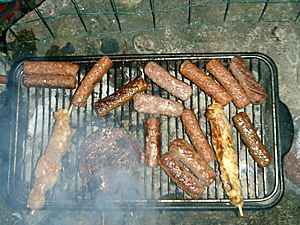
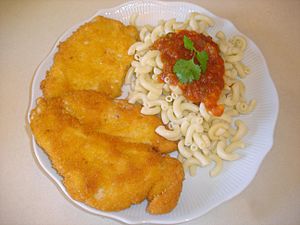
Chicken is the most popular meat in Israel, followed by turkey. Chicken is cooked in many ways, from simple roasted chicken to fancy casseroles with sauces like date syrup or tomato sauce.
Examples include chicken casserole with couscous (inspired by Moroccan Jewish cooking) and chicken with olives. Chicken albondigas (meatballs) in tomato sauce come from Jerusalem Sephardi cuisine.
Albondigas are made from ground meat. Similar to them is the more popular kufta, made of minced meat, herbs, and spices, cooked with tomato sauce or fruit syrups.
Grilled and barbecued meat are common. Israel has many small eateries selling beef and lamb kebab, shish taouk (chicken skewers), and merguez (spicy sausage). Outdoor barbecuing, called mangal or al ha-esh (on the fire), is a favorite Israeli activity.
Israel Independence Day is often celebrated with picnics or barbecues in parks.
Skewered goose liver is a dish from southern Tel Aviv, grilled with salt and pepper.
Chicken or lamb baked in the oven with potatoes and fried onions is very common.
Turkey schnitzel is an Israeli version of veal schnitzel. It was brought by Jews from Central Europe. Since veal was hard to find, chicken or turkey became a cheap and tasty substitute. Also, traditional Wiener schnitzel uses butter and oil, but in Israel, only oil is used because of kashrut rules.
Today, many people buy schnitzel already breaded and serve it with hummus, tahina, and salads. Yemenite Jews flavor it with hawaij (a spice mix). Vegetarian schnitzel made from soy is also popular.
Different types of sausage are part of Sephardi and Mizrahi cuisine. Jews from Tunisia make osban with ground meat or liver, rice, and spinach. Jews from Syria make smaller sausages called gheh, and Iraqi Jews make mumbar.
Moussaka is an oven-baked dish with layers of ground meat and eggplant.
Meat stews (chicken, lamb, and beef) are cooked with spices, pine nuts, herbs, onion, tomato sauce, or tahini. Peas, chickpeas, or beans are sometimes added.
Stuffed chicken in Israel is usually filled with rice, meat (lamb or beef), parsley, dried fruits like dates or apricots, and spices like cinnamon. It's then baked in the oven.
Dairy Delights
Many fresh, high-quality dairy products are available, like cottage cheese, white cheeses, yogurts, yellow cheeses, and salt-brined cheeses common in the Mediterranean.
Dairy farming has been a big part of Israeli agriculture since the country began. Israeli milk cows produce a lot of milk. In the early years, farms mainly made soft white cheese because it was cheap and healthy. It became a very important food during the time of saving and is still popular today.
Soft white cheese, gvina levana, is often called by its fat content (like 5% or 9%). It's eaten plain, mixed with fruit or vegetables, spread on bread, or used in pies.
Labneh is a yogurt-based white cheese common in the Middle East. It's sold plain, with za'atar, or in olive oil. It's often eaten for breakfast. In northern Israel, labneh balls preserved in olive oil are very common.
Tzfat cheese, a white cheese in brine similar to feta, was first made in Safed in 1837 and is still produced there by the same family. This dairy also became famous for its brinza cheese, which became known as Bulgarian cheese because it was popular among Jewish immigrants from Bulgaria in the 1950s.
In the 1980s, small dairies started making handmade cheeses from goat and sheep's milk, similar to traditional European cheeses. Many are made with organic milk.
Egg Dishes
Shakshuka, a North African dish of eggs poached in a spicy tomato sauce, is a national favorite, especially in winter. It's usually served in the same pan it was cooked in, with bread to soak up the sauce. Some versions include eggplant, chili peppers, spinach, or feta cheese.
Omelettes are seasoned with onions, herbs like dill, spinach, parsley, and spices like turmeric and cumin. They can also have cheese like safed or feta.
Haminados are eggs that are baked after being boiled. They are served with stews or meals, and sometimes for breakfast with jachnun and grated tomatoes.
Fresh Fruits
Israel is a top producer and exporter of fresh citrus fruits, and over forty types of fruit are grown there. These include oranges, grapefruits, tangerines, and the pomelit (a grapefruit-pomelo hybrid developed in Israel). Other fruits grown in Israel include avocados, bananas, apples, cherries, plums, lychees, peaches, grapes, dates, strawberries, tzabbar (prickly pear), persimmons, loquats, and pomegranates. Israelis eat a lot of fruit, about 160 kg (350 lbs) per person each year.
Many unique types of mango are from Israel, developed in the second half of the 20th century. The Maya mango, small and fragrant, is very popular. The Israeli mango season runs from May to October. Mangoes are used in mixed dishes and for making sorbet.
Many Israelis have fruit trees in their yards, especially citrus and mango. Mulberry trees are common in public gardens, and their fruit is served with desserts or as juice.
Fruit is eaten as a snack or dessert. Fresh-squeezed fruit juices are sold at street kiosks. Fruits are also added to chicken or meat dishes, and fresh fruit salad is often served after meals.
Baked Goods and Sweets


There's a strong tradition of home baking in Israel. Many professional bakers from Central Europe came to Israel and opened bakeries, called konditoria, shaping local tastes.
Now, there's a unique Israeli baking style that mixes European ingredients with Mediterranean and Middle Eastern ones, like halva, phyllo dough, dates, and rose water.
Examples include citrus-flavored semolina cakes (called basbousa or tishpishti in Sephardic bakeries). The Ashkenazi babka now includes halva or chocolate spread. There are also many types of apple cake. Cookies with crushed dates (ma'amoul) are served with coffee or tea.
Jerusalem kugel (kugel yerushalmi) is an Israeli version of the traditional noodle pudding, made with caramelized sugar and black pepper. It's usually baked overnight and eaten after synagogue services on Shabbat morning.
Bourekas are savory pastries brought by Jews from Turkey and the Balkans. They are made of flaky dough, often topped with sesame seeds, and filled with meat, chickpeas, cheese, spinach, potatoes, or mushrooms. Bourekas are sold everywhere and often served with hardboiled eggs and chopped vegetable salad.
Ashkenazi Jews from Vienna and Budapest brought fancy pastry-making traditions. cheesecake and strudel are popular home-baked items.
Jelly donuts (sufganiyot), traditionally filled with red jelly, are eaten for Hanukkah.
Tahini cookies are Israeli cookies made with tahini, flour, butter, and sugar, often topped with pine nuts.
Rugelach (small rolled pastries) are very popular in Israel.
Breads and Sandwiches
In the early Jewish communities, bread was baked at home. Commercial bakeries started in the mid-1800s. Expert bakers from Eastern and Central Europe in the 1920s-30s introduced handmade sourdough breads.
From the 1950s, mass-produced bread became common. But in the 1980s, special bakeries started making rich sourdough breads again, and Mediterranean-style breads with olives, cheese, or herbs. Now, there's a wide variety of breads available.
Challah bread is widely bought or made for Shabbat. It's usually an egg-rich braided bread, or round for Rosh Hashana (Jewish New Year).
Shabbat breads from Yemenite Jews, like Jachnun (thinly rolled dough baked overnight), Malawach (thin fried flatbread), and Kubaneh (yeast dough baked overnight), have become popular in Israel. Lahoh is a spongy, pancake-like bread.
Pita bread is a double-layered flatbread common in the Middle East. It's baked plain or with sesame or za'atar. Pita is used in many ways: stuffed with falafel or shawarma, filled with chocolate spread for kids, or torn to scoop up hummus and other dips.
A lafa is a larger, soft flatbread rolled up with falafel or shawarma. Different ethnic groups still bake their traditional flat breads, like lavash from Georgian Jews.
Sweets and Snacks
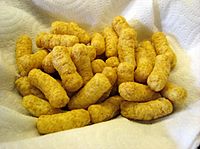
Baklava is a nut-filled phyllo pastry sweetened with syrup, served at celebrations in Jewish communities from the Middle East. It's also a common dessert in restaurants.
Kadaif is a pastry made from thin noodle threads filled with walnuts or pistachios and sweetened with syrup.
Halva is a sweet made from tehina and sugar, very popular in Israel. It's used in desserts like halva parfait.
Ma'amoul are small shortbread pastries filled with dates, pistachios, or walnuts.
Ozne Haman (Haman's ears) are sweet pastries filled with poppy seeds or other fillings, eaten for Purim. Their triangular shape might come from old pictures of Haman's hat.
Sunflower seeds, called garinim, are eaten everywhere. They are usually bought unshelled and cracked open. Pumpkin and watermelon seeds, pistachios, and sugar-coated peanuts are also popular.
Bamba is a soft, peanut-flavored snack that children love. Bissli is a crunchy snack made of deep-fried pasta, sold in flavors like BBQ and pizza.
Malabi is a creamy pudding from Turkey, made with milk or almond milk and cornstarch. It's sold as street food in cups with sweet syrup and toppings like pistachios or coconut. Supermarkets sell it in packages, and restaurants serve fancy versions. Sahlab is a similar dessert.
Watermelon with feta cheese salad is a popular dessert, sometimes with mint.
Krembo is a chocolate-coated marshmallow treat sold only in winter. It has a biscuit base, marshmallow cream, and a chocolate coating.
Milky is a popular dairy pudding with chocolate, vanilla, or mocha flavors, topped with whipped cream.
Sauces and Spices
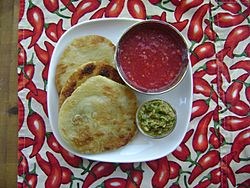
Chili-based hot sauces are very common in Israeli food, made from green or red chili peppers. They are served with appetizers, falafel, stews, and grilled meats, and mixed with hummus and tahina. These sauces, mostly from North African and Yemenite immigrants, are now widely eaten.
Skhug is a spicy chili pepper sauce from Yemenite Jews, and it's one of Israel's most popular condiments. It's added to falafel and hummus, spread on fish, or used in sandwiches for extra spice.
Other hot sauces include the Tunisian harissa and the filfel chuma from Libyan Jews.
Amba is a pickled mango sauce, brought by Iraqi Jews. It's commonly used with shawarma, kebabs, and falafel.
Concentrated juices made from grape, carob, pomegranate, and date are common. They are used in stews, soups, or as toppings for desserts like malabi.
Almond syrup flavored with rose water or orange blossom water is a common flavor for desserts and sometimes added to drinks like arak.
Sumac, a dark red spice, is made by grinding dried berries of the sumac bush.
Drinks
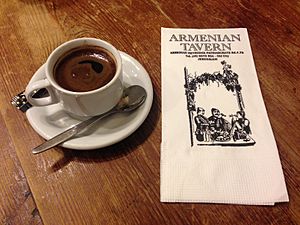
Israel has a strong coffee-drinking culture. Coffee is prepared in many ways: instant, iced, latte, Italian-style espresso, or Turkish coffee, sometimes with cardamom. Jewish writers and artists from Germany and Austria who came to Israel before World War II brought the idea of the Viennese coffee house with its relaxed atmosphere.
Cafés are everywhere in cities and are popular meeting places. Most serve baked goods and sandwiches, and many also serve light meals. They often have outdoor seating to enjoy Israel's Mediterranean climate. Tel Aviv is famous for its café culture.
Tea is also widely drunk, served at cafés and at home. It's prepared in many ways, from plain black tea with sugar to tea with lemon, milk, or mint (nana). Tea with rose water is also common.
Limonana, a lemonade made from fresh lemons and mint, was invented in Israel in the early 1990s and is now a summer favorite across the Middle East. Rimonana is similar, made with pomegranate juice and mint.
Sahlab is a drinkable pudding, usually made with cornstarch today. It's sold in markets or by street vendors, especially in winter, topped with cinnamon and chopped pistachios.
Malt beer, called black beer (bira shḥora), is a non-alcoholic drink made in Israel since before it became a state. Goldstar and Maccabi are Israeli beers. Recently, small breweries have started making new beer brands.
Arak is a clear, anise-flavored alcoholic drink common in Israel and the Middle East. It's often served with ice and water, which makes it turn milky white.
Wine in Israel
Israeli wine is produced by hundreds of wineries, from small family businesses to large companies. Most Israelis drink wine in moderation, usually with meals or at social events. While wine drinking is lower than in some other Mediterranean countries, it has been growing since the 1980s as Israel produces more high-quality wines. Wines are also imported from other countries.
Most wine made from the 1880s until the 1980s was sweet, kosher wine. Then, the Golan Heights Winery started making more dry or semi-dry wines. These wines are kosher and have won awards in international competitions.
Foods Not Always Kosher
Some foods that are not allowed by Jewish dietary laws (kashrut) or Muslim dietary laws (halal) can still be found in Israel. For example, pork and shellfish are available in many non-kosher restaurants and some stores. A modern Hebrew word for pork is "white meat."
Eating Out in Israel
Street Foods
In Israel, "street food" is fast food often eaten while standing. Here are some popular ones:

Falafel are fried balls of spiced chickpeas. They are often served in a pita with pickles, tahina, hummus, chopped vegetable salad, and hot sauce. There are different kinds, like green falafel with parsley and coriander, or yellow falafel with turmeric.
Shawarma is usually made with turkey and lamb fat in Israel. The meat is sliced, marinated, and roasted on a large rotating skewer. The cooked meat is shaved off and put into a pita with hummus and tahina, or with onions, French fries, salads, and pickles.
Shakshouka, originally a breakfast for workers, is simply fried eggs in spicy tomato sauce. It's usually served in the same frying pan with thick slices of white bread to soak up the sauce.
Jerusalem mixed grill, or me'urav Yerushalmi, is a mix of chicken parts and lamb with onion, garlic, and spices. It's a very popular street food in Jerusalem and across Israel.
Jerusalem bagels are long, oblong-shaped bagels, covered in za’atar or sesame seeds. They are soft, chewy, and sweet, and are a favorite snack at football games.
Malabi is a creamy pudding sold from carts or stalls in cups with sweet syrup and crunchy toppings.
Sabikh is a traditional sandwich brought by Mizrahi Jews. It's a pita filled with fried eggplant, hardboiled egg, salad, tehina, and pickles.
A Tunisian sandwich is usually a baguette with fillings like tuna, egg, pickled lemon, and fried hot green pepper.
Places to Eat

Israel has thousands of restaurants, casual eateries, cafés, and bars. Here are some unique Israeli places to eat:
Falafel stands are common everywhere. Vendors often offer extra toppings like chips, fried eggplant, and pickles.
A hummusia is a place that mainly serves hummus with a few extras like tahina, hardboiled egg, falafel, and pita bread.
Misada Mizrahit (meaning "Eastern restaurant") refers to Mizrahi Jewish, Middle Eastern, or Arabic restaurants. These popular and inexpensive places often offer a selection of meze salads, followed by grilled meat with French fries, and a simple dessert.
Steakiyot are meat grills that sell chicken, turkey, or lamb as steak, shishlik, kebab, and even Jerusalem mixed grill, all in pita or taboon bread.
Holiday Meals
Shabbat Meals
Friday night dinners (the start of Shabbat) are usually family meals. Along with family favorites, traditional dishes are served, like challah bread, chicken soup, salads, chicken or meat dishes, and cakes or fruits for dessert.
Shabbat lunch is also an important meal. For centuries, Jewish communities made meat stews that cooked slowly overnight. This was done so they wouldn't have to cook on Shabbat itself.
In modern Israel, this hearty meal is still eaten on Shabbat, even in homes that are not strictly religious. It's also served in some restaurants during the week.
The main ingredients are meat and beans or rice, cooked slowly overnight. Ashkenazi cholent usually has meat, potatoes, barley, and beans. Sephardi hamin has chicken or meat, rice, beans, garlic, potatoes, and whole eggs in their shells (called haminados).
For desserts or casual gatherings on Shabbat, people bake many kinds of cakes on Fridays, like sponge cake, citrus semolina cake, and fruit and nut cakes.
Rosh Hashanah (Jewish New Year)
Rosh Hashana, the Jewish New Year, is celebrated with festive family meals and symbolic foods. Sweetness is a main theme. Dinners usually start with apples dipped in honey and end with honey cake.
The challah bread is often round and has raisins, drizzled with honey. Other symbolic fruits and vegetables like pomegranates, carrots, and beets are eaten.
Fish dishes, symbolizing abundance, are served. For example, gefilte fish is traditional for Ashkenazim, while Moroccan Jews make the spicy fish dish, chraime.
Honey cake (lekach) is a common dessert, served with tea or coffee. Dishes cooked with pomegranate juice are also popular.
Hanukkah
The holiday of Hanukkah is celebrated by eating traditional foods fried in oil. This remembers the miracle where a small amount of oil lasted for eight days.
The two most popular Hanukkah foods are potato pancakes, levivot (also known as latkes), and jelly doughnuts, called sufganiyot in Hebrew. These are both deep-fried in oil.
Hanukkah pancakes can be made from potatoes, cheese, corn, spinach, zucchini, or sweet potato. Bakeries in Israel offer many new fillings for sufganiyot, like chocolate, vanilla, or cappuccino cream. Smaller "mini" sufganiyot have also become popular.
Tu BiShvat
Tu BiShvat is a minor Jewish holiday in late January or early February, marking the "New Year of the Trees." People plant trees and eat dried fruits and nuts, especially figs, dates, raisins, carob, and almonds.
Many Israelis celebrate with a special kabbalistic meal called a Tu BiShvat seder, which includes a feast of fruits and four cups of wine.
Purim
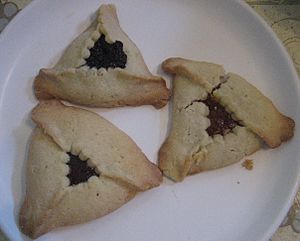
The festival of Purim celebrates how the Jewish people were saved from a plot to destroy them in ancient Persia. It's a day of joy and fun, where children and adults wear costumes. People usually have a festive meal, seudat Purim, in the late afternoon, often with wine.
Many people prepare food packages called mishloach manot (sending of portions) to give to neighbors, friends, and family. These often include wine, baked goods, fruit, and sweets.
The food most linked to Purim is oznei haman ("Haman's ears"). These are three-cornered pastries usually filled with poppy seeds, but also other fillings.
Passover
The week-long holiday of Passover in the spring remembers the Exodus from Egypt. In Israel, it's a time for visiting friends and family, traveling, and having the traditional ritual dinner called the Seder on the first night.
Foods with ḥametz (leavening or yeast), like bread and pastries, cannot be eaten during Passover. Ashkenazim also don't eat legumes (beans, peas, etc.). Over centuries, Jewish cooks have created dishes using other ingredients for Passover.
Chicken soup with matzah dumplings (kneidlach) is often a starter for the Seder meal. Spring vegetables like asparagus and artichokes often go with the meal.
After Passover, the celebration of Mimouna takes place. This tradition was brought by Jewish communities from North Africa. In the evening, a feast of fruit, sweets, and pastries is set out for visitors. The first leavened food eaten after Passover is a thin crepe called a mofletta, served with honey or jam. The next day is celebrated with outdoor picnics with salads and barbecued meat.
Shavuot
In early summer, the Jewish harvest festival of Shavuot is celebrated. Shavuot marks the peak of the new grain harvest and the ripening of the first fruits. It's also a time when milk was historically most plentiful.
To celebrate this holiday, many types of dairy foods are eaten. These include cheeses and yogurts, cheese-based pies and quiches (called pashtidot), cheese blintzes, and cheesecake made with soft white cheese or cream cheese.
See also
 In Spanish: Gastronomía de Israel para niños
In Spanish: Gastronomía de Israel para niños


